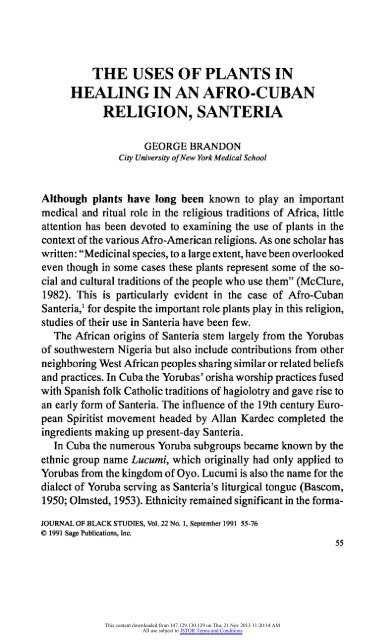The Uses of Plants in Healing in an Afro-Cuban Religion, Santeria
by George Brandon
by George Brandon
- No tags were found...
You also want an ePaper? Increase the reach of your titles
YUMPU automatically turns print PDFs into web optimized ePapers that Google loves.
THE USES OF PLANTS IN<br />
HEALING IN AN AFRO-CUBAN<br />
RELIGION, SANTERIA<br />
GEORGE BRANDON<br />
City University <strong>of</strong> New York Medical School<br />
Although pl<strong>an</strong>ts have long been known to play <strong>an</strong> import<strong>an</strong>t<br />
medical <strong>an</strong>d ritual role <strong>in</strong> the religious traditions <strong>of</strong> Africa, little<br />
attention has been devoted to exam<strong>in</strong><strong>in</strong>g the use <strong>of</strong> pl<strong>an</strong>ts <strong>in</strong> the<br />
context <strong>of</strong> the various <strong>Afro</strong>-Americ<strong>an</strong> religions. As one scholar has<br />
written: "Medic<strong>in</strong>al species, to a larg extent, have been overlooked<br />
even though <strong>in</strong> some cases these pl<strong>an</strong>ts represent some <strong>of</strong> the social<br />
<strong>an</strong>d cultural traditions <strong>of</strong> the people who use them" (McClure,<br />
1982). This is particularly evident <strong>in</strong> the case <strong>of</strong> <strong>Afro</strong>-Cub<strong>an</strong><br />
S<strong>an</strong>teria,1 for despite the import<strong>an</strong>t role pl<strong>an</strong>ts play <strong>in</strong> this religion,<br />
studies <strong>of</strong> their use <strong>in</strong> S<strong>an</strong>teria have been few.<br />
<strong>The</strong> Afric<strong>an</strong> orig<strong>in</strong>s <strong>of</strong> S<strong>an</strong>teria stem largely from the Yorubas<br />
<strong>of</strong> southwestern Nigeria but also <strong>in</strong>clude contributions from other<br />
neighbor<strong>in</strong>g West Afric<strong>an</strong> peoples shar<strong>in</strong>g similar or related beliefs<br />
<strong>an</strong>d practices. In Cuba the Yorubas' orisha worshi practices fused<br />
with Sp<strong>an</strong>ish folk Catholic traditions <strong>of</strong> hagiolotry <strong>an</strong>d gave rise to<br />
<strong>an</strong> early form <strong>of</strong> S<strong>an</strong>teria. <strong>The</strong> <strong>in</strong>fluence <strong>of</strong> the 19th century Europe<strong>an</strong><br />
Spiritist movement headed by All<strong>an</strong> Kardec completed the<br />
<strong>in</strong>gredients mak<strong>in</strong>g up present-day S<strong>an</strong>teria.<br />
In Cuba the numerous Yoruba subgroups became known by the<br />
ethnic group name Lucumi, which orig<strong>in</strong>ally had only applied to<br />
Yorubas from the k<strong>in</strong>gdom <strong>of</strong> Oyo. Lucumis also the name for the<br />
dialect <strong>of</strong> Yoruba serv<strong>in</strong>g as S<strong>an</strong>teria's liturgical tongue (Bascom,<br />
1950; Olmsted, 1953). Ethnicity rema<strong>in</strong>ed signific<strong>an</strong>t <strong>in</strong> the forma-<br />
JOURNAL OF BLACK STUDIES, Vol. 22 No. 1, September 1991 55-76<br />
X 1991 Sage Publications, Inc.<br />
55<br />
This content downloaded from 147.129.130.129 on Thu, 21 Nov 2013 11:20:14 AM<br />
All use subject to JSTOR Terms <strong>an</strong>d Conditions


















